Have you ever wondered how you could be a remarkable speaker?
When I started working at Apple in 1986 I was afraid of public speaking—for one thing, working for the division run by Steve Jobs was intimidating: “How could I possibly measure up to Steve?” But if you want to succeed as an evangelist and CEO, you must learn how to make speeches.
It took me twenty years to get comfortable with public speaking, and this podcast explains what I’ve learned. I am not content that you merely survive speeches. I want you to get standing ovations.
Have something interesting to say. This is 80 percent of the battle. It’s much easier to give a great speech if you have something to communicate. End of discussion. If you don’t have anything to say, decline the speech. If you don’t want to decline, then do some research and get something interesting to say.
In this episode of Remarkable People with Guy Kawasaki:
-
How to be a remarkable speaker
-
Winning advice for creating presentations
- Follow my rule of 10-20-30
Question of the week!
This week’s question is:
Question: How have you gotten over your fear of public speaking? Share on X
Use the #remarkablepeople hashtag to join the conversation!
Where to subscribe: Apple Podcast | Google Podcasts
Follow Remarkable People Host, Guy Kawasaki
Guy Kawasaki: How to Be a Remarkable Speaker. I'm Guy Kawasaki, and this is the Remarkable People podcast. This is Remarkable People.
Enter your name and email address below and I'll send you periodic updates about the podcast.
Hello, this is Guy Kawasaki, and this is the Remarkable People podcast.
The format of this podcast is usually that I interview a remarkable person, someone like Jane Goodall, Leon Panetta, Woz, Margaret Atwood, Martha Stewart, to drop a few names, but in this case, I'm going to try something different.
There is no other guest in this episode. It's just going to be me talking about how you can gain some remarkable skills. Specifically today, I'm going to talk about: How to Be a Remarkable Speaker. I'm trying this new format. Let me know what you think, and here we go.
Number One: The first thing is to have something to say. This is kind of a “duh-ism.” Of course you have something to say if you're speaking, but I found that it's not always true. Sometimes people want to speak because they want the attention, the positioning. You should speak when you have something important to say. If you don't have something important to say, shut up.
Number Two is to do your homework. If there is something that is skipped by most speakers, it is that they do not do their homework before a presentation. If it is a small group, then LinkedIn is the greatest gift from God ever. Look up everybody who's going to be in the room. Figure out where they went to school, where they worked, who you might know in common.
If it's a large group, figure out who's in the audience. It may be an industry group. Then, what are the major issues in the industry? What threats do they face? What looks really good for the industry? Get that kind of background information.
If it is a company, figure out what the company makes. What kind of product? What kind of service? Figure out who the company serves. What kind of customer? Figure out the current status of the company. Are they growing? Are they in transition? Are they having a difficult time? Figure all that kind of stuff out so that you can make your speech as relevant as possible.
Number Three: Follow the ten/twenty/thirty rule. The ten/twenty/thirty rule of presentations and speeches is that you should use about ten slides. You should be able to give those ten slides in twenty minutes, and no font should be smaller than thirty points.
Ten slides because most people can't handle more than ten thoughts in a presentation. You'd be lucky to get ten points across. Twenty minutes is because many meetings while scheduled for a longer time, start late, end early, people leave, people come, people go. You just never know what's going to happen, and if you're prepared to do something in twenty minutes, you can always go long. But if you're prepared to have sixty minutes and you have to go short, you are going to be in a lot of trouble.
The thirty-point font rule is that I think, the bigger the font, the better the slide. The better the slide, the better the speaker. Many people use much too smaller font and they try to put complete sentences on the slide. Then they read the complete sentence, and that's when you start to lose your audience. Because the audience figures out that, “Oh, this person is reading the slides verbatim. I can read silently to myself, faster than this person can read them to me,” and you completely, utterly lose your audience.
So ten slides, twenty minutes, thirty- point font, and as a little FYI for you, the slides of Steve Jobs had 190-point font. 190 points. Let's just say that you and I are not Steve Jobs so we can't use 190-point font, but he certainly didn't use an eight, ten or twelve-point font and read things to the audience, so the bigger the font, the better the speaker. Ten slides; twenty minutes; thirty-point font.
Speaker:
“It is now 1984. It appears IBM wants it all. Apple is perceived to be the only hope to offer IBM a run for its money. Dealers initially welcoming IBM with open arms now fear an IBM dominated and controlled future. They're increasingly turning back to Apple as the only force that can ensure their future freedom.
IBM wants it all and is aiming its guns on its last obstacle to industry control: Apple. Will Big Blue dominate the entire computer industry? The entire information age? Was George Orwell, right?”
Guy Kawasaki:
Number four is my recommendation that you make your background black, or at least in every dark. White text on a black background is much easier to read. It shows gravitas. It shows that you at least know how to make a master slide with a black or dark background, and then put white text on top of the black background.
Think about this. Have you ever seen movie credits where it's a black text on a white background? Never. It's always white text on a black background.
Black is the new black. An added advantage of this is that the audience cannot tell where your slide ends and the outside frame begins because everything will be black.
Number Five: Get a small room. It's much easier to give a speech in a small room when the audience is packed in. There's a sense of energy, a sense of exclusivity, a sense of scarcity. You may not have a choice of the room, but then maybe you can request the type of seating.
Theater seating holds many more people than classroom seating. If you can, ask for classroom seating. Classroom seating means that there are tables in front of people. Those tables take up space.
Number Six: Try to speak early in the conference. The first day, the first morning. Always try to get a morning speech. People are more attentive. There's higher probability of attendance.
In the afternoon, people are sleepy, people are leaving, and the worst slot of all, and don't let any meeting planner tell you it's a great honor to be the Closing Speaker. The worst slot of all is the Closing Keynote because people are worried about their bags getting lost. People are worried about getting to the airport on time. People are worried about making their flights. They're suffering from the Gala Dinner that happened the night before, and they got back at 2:00 AM, after painting the town red.
Number Seven: Number seven is, that prior to a speech, pre-circulate with the audience. Meet people, shake their hands, take pictures with them. You want to create some relationships, some friendships, and the reason is when you stand up and you look over the crowd, you want to see people that you've already met. You want to see people that you have befriended. You want to see smiling faces. It'll build your confidence.
Many speakers believe that they need to be protected from the audience. They have a PR person. They have a driver. They have a guard. They have an entourage because they need to be away from the great unwashed masses. I think that is absolutely a mistake. That you want the audience to support you, to know you, to laugh with you, to smile with you, and the way you catalyze that is to meet them before the speech.
Number eight is that you customize your intro. Going back to number two, where you did your homework, well, you can customize your intro because you've done the homework. You know what industry this company's in. Who their competitors are. Maybe buy some of their stuff. You visit their offices. You've visit their factories. You do whatever it is. You customize the intro.
Establish that you're not just jutting in, speaking, and leaving. That there is some kind of emotional investment on your part to customize the intro.
Number Nine: Number nine is my belief that you should focus on entertaining as opposed to educating an audience. If you entertain your audience, I promise you, you will also probably educate them, but if you set off just to educate, then I think you'll bore them and you won't educate them and you will be a crappy speaker.
Steven Hawking:
To begin, I'd like to share with you—Imagine, I saw first time I met an IBM mainframe. Never trust a computer you can't live, but right now I'd like to sit back and listen. So it is with considerable pride that I introduce a man who's been like a father to me, Steve Jobs.
Guy Kawasaki:
Great Keynote speakers entertain their audiences and a by-product of that is education.
Number Ten is the way to entertain your audience is to tell stories. I can't tell you how many speeches I've sat through where some CEO says, “I have patent pending curve, jumping paradigm, shifting enterprise class, scalable product or service.” Every one of them uses adjectives like that. And those adjectives are meaningless because every one of them use the same adjectives.
Instead, you should tell a story. Two guys in a garage, two gals in a garage thinking, “There must be a better way. Why do I have to work for a large company? Why do I have to attend a university? Why do I have to work for the government? There must be a better way. Why can't computers be smaller and cheaper and easier to use? So we started Apple.”
Number eleven, and closely related to number ten, is cut the sales pitch. When you make a speech, you need to think about what the people want to hear. What are they interested in? What entertains them? What even educates them? Not what you want to sell.
People are not sitting in there thinking, how can I help this person make budget, make quota, make commission. They're thinking, “What's in it for me? What can I get out of this speech that will make my life better?” If you entertain and educate the audience, I guarantee you there'll be much more predisposed to buying your product or service.
And the final recommendation is: practice. Everybody who ever gave advice about speaking tells you to practice. But most people have the most bizarre reaction to this recommendation, and their reaction is, “Yes, I understand the need for practice, but I am a natural. I am going to get up on that stage and I am going to rise to the occasion.”
Let me tell you something. If you ever find yourself thinking that you're a natural, just remember that Steve Jobs would practice his introductions for weeks, and if Steve Jobs needs practice, you need practice.
Give your speech to your dog, to your iPhone, to your spouse. Give it to your company, give it to anybody who listened. Repetition is where it's at. You cannot go up there and wing it. You have to feel so comfortable that you don't even need slides. Pretend your slides are gone. Can you give your speech without slides? And that only comes with practice.
When I create a new speech, it takes me twenty-five times of giving that speech to really perform it well.
So these are my Top eleven plus bonus, so I guess that's twelve ways to become a remarkable speaker. Remember, they are: Have something to say. Do your homework. Follow the Ten/Twenty/Thirty rule. Go black with your background. Get a small room or at least set it classroom style. Speak early in the conference. Pre-circulate. Customize your introduction. Focus on entertaining. Tell a lot of stories. Cut the sales pitch, and practice, and if you do these things, you will be a remarkable speaker.
My thanks to Jeff Sieh and Peg Fitzpatrick who make this podcast remarkable.
Sign up to receive email updates

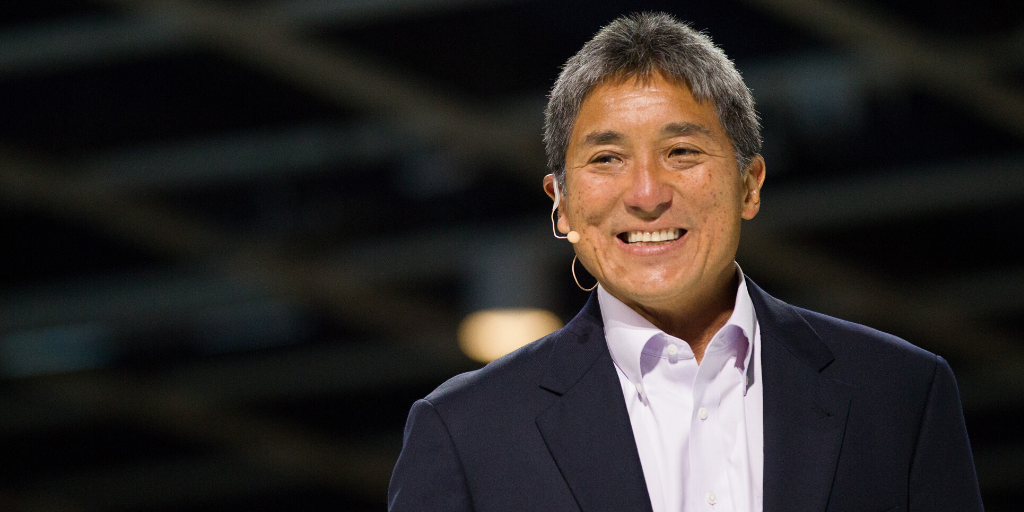
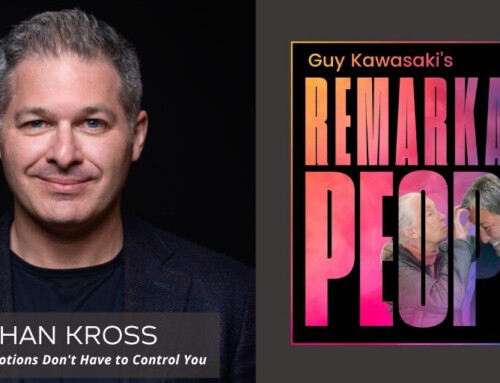

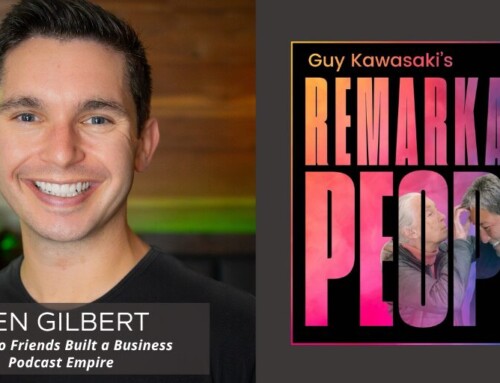
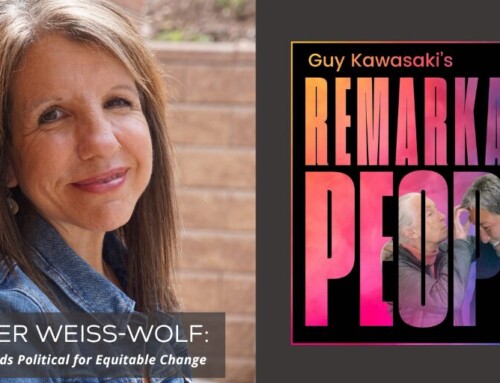
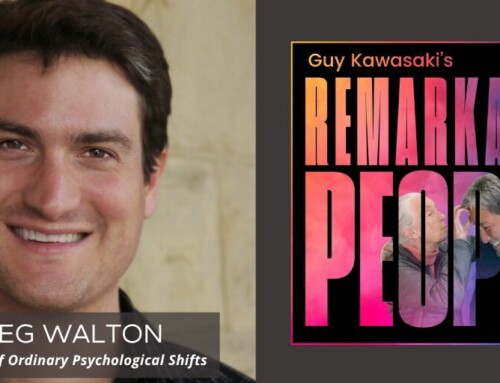
request the transcript please
Once again , you unselfishly share your experience and insights to give others the tips to help them improve themselves. This program really does give you the opportunity to shine as an informed and genuinely interested interviewer who can show his awe and admiration for others. That friendly demeanor makes those you interview more at ease based on what I have heard in three of the programs.
Guy, as someone who, like you, have interviewed a who’s who, I’ve found myself often disappointed. Despite or maybe even because of their fame, they tend to “play old tapes”, have more to risk from spontaneity, and en toto don’t live up to their perceived eminence. (I’m not referring to you–You may recall you were a guest on my KALW (NPR-San Francisco) show.
So, I have, like you, taken to giving mini-keynotes. The difference is that I have concluded that the benefit of scripting is outweighed by the sterility that inheres. So I merely keep an outline in front of me and I ad lib. Here’s a sample. https://www.youtube.com/watch?v=0T8WIP7wCAI&t=646s Perhaps you might try that one time and see how you like it. After all, you can always press delete.
Thank you Guy. This is a very good podcast on how to make a speech! I like this format at times too. It great! You are an incredible speaker yourself! I like your points that are short and to the point. It is perfect! Thank you!
Hi Guy, I love your books, your talks.
Can I make one suggestion? Dont include any kind of music. Just your voice. nothing else.
That would be awesome.
Just suggesting.
Guy – thanks for the tips. I am glad to see you in the Podcast space and I hope to launch one of my own this year! Mahalo.
Guy, I think I left my comments on the wrong page so here they are again. I love your Remarkable People podcasts and this one with you giving advice on presentations is a jewel. I recall long ago in London when you were evaluating pitches of entrepreneurs I was working with. I have benefited enormously from your consolidated, succinct, practical and most valuable ways to become a remarkable speaker. And then again when you speak it all looks so easy..I have saved this to listen before I do not only a speech but workshops as well. Thank you again for sharing your wisdom.
Love it – and remember, “Do the Last Thing First…!”
Very much appreciate this, Guy. And thanks for ‘opening’ my weekly podcast reminder by email. If you get the chance to make the 3-minute listen and have a comment, that would be great! Thanks again. Bill Carroll (Yourpathworks.com)